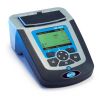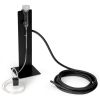Hach DR3900 Laboratory VIS Spectrophotometer
The Hach DR3900 is a benchtop visible spectrum, split beam spectrophotometer for laboratory water analysis.
Features
- Simple Preparation with TNTplus® vials
- Store hundreds of user-determined methods
- Claros™ connectivity
- Free ground shipping
- Expedited repair and warranty service
- Lifetime technical support
- More
Overview
The Hach DR 3900 is a benchtop visible spectrum (320-1100 nm) split beam spectrophotometer with over 220 pre-programmed methods optimized for laboratory water analysis. The DR3900 spectrophotometer is optimized for safe processes and accurate results daily. Control parameters like Ammonium, COD, Phosphate, Nitrate and many others are easy to test.
Simple Preparation
TNTplus® vials use Dosicaps - freeze-dried reagents integrated into a sealed cap - that are easier to use than Powder Pillows or Liquid Reagents, without any risk of contamination. The boxes and vials are color-coded for fast and easy parameter and range recognition of the test needed. Step-by-step illustrated test methods are printed on the box as a quick reference and can also be called up in the instrument menu.
Comprehensive Documentation
Measurement results are documented on a detailed level with a timestamp, operator ID, absorbance reading, and calculated concentration. The 2D barcode delivers the lot number and expiry date, logged with every result. For accreditation, the certificate of analysis can be called up just by wiping the reagent box towards the RFID sensor.
Fast Execution
The Hach DR 3900 spectrophotometer automatically reads a 2D barcode on the TNTplus vial to identify the appropriate method and take the measurement. The vial spins to take 10-fold absorbance readings that will be averaged for result determination to exclude scratches and fingerprints. Instrument calibration verification and high instrument stability all combine to eliminate the need to run reagent blanks.
Customizable
With the ability to store hundreds of user-determined methods, operators are able to tailor the DR 3900 to meet the everyday needs of the facility. Optimizing and customizing the method portfolio, combined with regular software updates and Claros™ connectivity, makes the DR3900 the ultimate solution to water quality lab needs.
- Beam Height: 10 mm
- Data Logger: 2000 measured values (Result, Date, Time, Sample ID, User ID)
- Display: 7" TFT
- Display Resolution: WVGA (800 pix x 480 pix)
- Display Size: 7 inch (17.8 cm)
- Display Type: Colored touch-screen
- Enclosure Rating: IP30
- Interfaces: USB type A, (2)USB type B, Ethernet, RFID module
- Light Source: Gas-filled Tungsten (visible)
- Manual Languages: English, French (CDN), Spanish (SA), Portuguese (BR),Chinese, Japanese, Korean
- Max. operating humidity: 80 %
- Max. Storage Humidity: 80 %
- Operating Conditions: 10 - 40 °C
- Operating Mode: Transmittance (%), Absorbance and Concentration, Scanning
- Optical System: Reference beam, spectral
- Photometric Accuracy: 5 mAbs @ 0.0 - 0.5 Abs
- Photometric Accuracy 2: 1 % at 0.50 - 2.0 Abs
- Photometric Linearity: < 0.5 % - 2 Abs
- Photometric Linearity 2: ≤ 0.01 % at >2 Abs with neutral glass at 546 nm
- Photometric Measuring Range: ± 3.0 Abs (wavelength range 340 - 900 nm)
- Power Requirements: With external power supply
- Power Requirements (Hz): 50/60 Hz
- Power Requirements (Voltage): 110 - 240 V AC
- Power Supply: Benchtop Power Supply
- Preprogrammed Methods: > 240
- Region: US
- Sample Cell Compatibility: Rectangular: 10, 20, 30, 50 mm, 1 inch; round: 13 mm, 16 mm, 1 inch
- Scanning Speed: > 8 nm/S (in steps of 1 nm)
- Source Lamp: Gas-filled Tungsten (visible)
- Specific Technology: RFID for easy method update, sample ID and Certificate of Analysis
- Spectral Bandwidth: 5 nm ± 1 nm
- Standard accessories: None
- Storage Conditions: -30 - 60 °C
- Stray Light: < 0.1 % T at 340 nm with NaNO2
- User Interface Languages: Bulgarian, Chinese, Croatian, Czech, Danish, Dutch, English, Finnish, French, German, Greek, Hungarian, Italian, Japanese, Korean, Polish, Portuguese - Brasilian, Potuguese, Russian, Serbian, Slovakian, Slowenian, Spanish, Swedish, Turkish
- User Programs: 100
- Warranty: 12 months
- Wavelength Accuracy: ± 1.5 nm (wavelength range 340 - 900 nm)
- Wavelength Calibration: Automatic
- Wavelength Range: 320 - 1100 nm
- Wavelength Reproducibility: ± 0.1 nm
- Wavelength Resolution: 1 nm
- Wavelength Selection: Automatic, based on method selection
- Weight: 4.2 kg
- (1) DR3900 Spectrophotometer
- (1) Adapter A for 1 in. round and 1 cm square cells
- (1) Matched pair of 1 in. square glass sample cells
- (1) Light shield
- (1) Dust cover
- (1) Printed basic user manual
- (1) Benchtop power supply with 115 and 230V power cords
In The News
Poás Volcano Gives a Glimpse of Life on Mars
To get an idea of what life would be like on Mars, you don’t need to travel millions of miles away--instead, you could go to Costa Rica and visit the Poás Volcano and its crater lake, Laguna Caliente. “Collectively, the suite of alteration minerals at Poás crater and identified across Mars at relict hydrothermal sites shows strong correlation, indicating the high temperature and highly acidic geochemical processes occurring at Poás are quite relevant to understanding past hydrothermal processes on Mars,” says Justin Wang, a graduate student at the University of Colorado, Boulder. He is currently conducting research at the Laboratory for Atmospheric and Space Physics alongside his advisor, Brian Hynek. Wang is currently a master's student in aerospace engineering.
Read MoreWildfire Prevention in the Sierra Nevada Region with the Yuba Watershed Institute
Though recent wildfires have sparked new conversations about wildfire management and response, groups like the Yuba Watershed Institute have been monitoring the forests and water resources of the Sierra Nevada region for decades, managing approximately 5,000 acres of land with the Bureau of Land Management (BLM) and about 7,000 acres in private land partnerships. The goal of the Institute is to work with local communities and land agencies to improve watershed and forestry management through informed practices and public outreach. The goals of the Yuba Watershed Institute are three-fold: Improve the ability of fire suppression agencies like the California Department of Forestry and Fire Protection ( CAL FIRE ) and the US Forest Service.
Read MoreWave Sensors Integration with NexSens Buoys: A Cutting-Edge Solution for Wave Measurment
Real-time wave data supports accurate weather prediction, safe and efficient maritime operations, and provides valuable safety and operating condition information for recreation and commercial fishing. Understanding wave dynamics also helps with the design of protective coastal structures like seawalls, breakwaters, and jetties. It also supports better prediction of their impact on sediment transport and coastal geomorphology. Wave data is a key factor in qualifying and designing offshore wind farms and harnessing kinetic energy for electrical generation. It helps with the understanding of ocean-atmosphere interactions and contributes to studies of sea-level rise and climate change impacts.
Read More



















































































